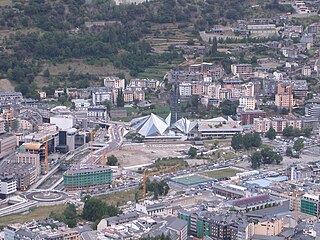
The politics of Andorra take place in a framework of a parliamentary constitutional monarchy, and a multi-party system. Executive power is exercised by the government, with the Head of Government of Andorra as chief executive. Legislative power is vested in both the government and parliament. The judiciary is independent of the executive and the legislature.

Andorra consists of seven communities known as parishes. Until relatively recently, it had only six parishes; the seventh, Escaldes–Engordany, was created in 1978.

Escaldes–Engordany is one of the seven parishes of Andorra. The Escaldes–Engordany parish was founded in 1978 by being separated from Andorra la Vella. The parish is composed of the areas les Escaldes, Engordany, Els Vilars d'Engordany, Engolasters, and El Fener. As of 2014 it has a population of 13,634, the second largest population after Andorra la Vella. Notable events include the town's annual jazz festival. It borders four parishes: Encamp to the north and northeast, Sant Julià de Lòria in the southwest, Andorra la Vella in the west, and La Massana in the northwest. Escaldes–Engordany also borders Spain in the east, south and southeast.

There are two types of elections in Andorra: parliamentary elections and local elections. The 28 members of the General Council of the Valleys are elected in parliamentary elections for a maximum term of four years. In the local elections, the council members of the seven parishes of Andorra are elected for a four-year term.

The General Council is the unicameral parliament of Andorra. It is sometimes referred to as the General Council of the Valleys because it was the historical name and to distinguish it from similarly named bodies in the Val d'Aran and in France.
ISO 3166-2:AD is the entry for Andorra in ISO 3166-2, part of the ISO 3166 standard published by the International Organization for Standardization (ISO), which defines codes for the names of the principal subdivisions of all countries coded in ISO 3166-1.

Early parliamentary elections were held in Andorra on 3 April 2011 after the General Council of Andorra was dissolved over problems in passing important laws, including the budget and laws related to a value added tax.

Antoni Martí Petit was an Andorran architect and politician who served as the prime minister of Andorra between 2011 and 2019, when he was elected on the ticket of the Democrats for Andorra.

Parliamentary elections were held in Andorra on 10 December 1989, with a second round of voting on 17 December. Following the elections, Òscar Ribas Reig became Prime Minister, elected on 12 January 1990 by a vote of 23−5.

Parliamentary elections were held in Andorra on 5 April 1992, with a second round of voting on 12 April. Following the elections, Òscar Ribas Reig remained Prime Minister.

The Democratic National Initiative was a political party in Andorra.

The 1983 Andorran local elections were held on 12 December. Voters elected the council members of the seven parishes of Andorra. For first time since 1867, local elections were not hold on the same day as parliamentary elections. This was also the first time that the totality of the council seats were up for election.

The 1987 Andorran local elections were held on 13 and 20 December. Voters elected the council members of the seven parishes of Andorra. Following the election, the communal councils elected the mayors and deputy mayors.
The 1991 Andorran local elections were held on 15 and 22 December. Voters elected the council members of the seven parishes of Andorra. Following the election, the communal councils elected the mayors and deputy mayors.
The 2019 Andorran local elections were held on 15 December, to elect all councillors in the seven parishes of Andorra.

Parliamentary elections were held in Andorra on 16 December 1955 to renew half of the members of the 24-seat General Council. In constituencies where no candidate won in the first round, a second round was held on 24 December.

Parliamentary elections were held in Andorra on 13 December 1979 to elect half of the members of the General Council. In constituencies where no candidate received a majority of the vote, a second round of voting on 20 December.

Supplementary elections were held in Andorra on 21 July 1978 to elect four members to the General Council. The elections took place following the creation of the parish of Escaldes–Engordany by splitting the parish of Andorra la Vella. The General Council had four members for each parish, and so was increased in size from 24 to 28 seats. Of the four members previously representing the parish of Andorra la Vella, two represented the town of Andorra la Vella and two represented Les Escaldes. As a result of the split of the parish, two additional members were elected from Andorra la Vella and two from Escaldes–Engordany so that each would have four members.

Parliamentary elections were held in Andorra on 12 December 1975 to elect half of the members of the General Council. In constituencies where not all seats were filled in the first round, a second round was held on 19 December. They were the first elections in which women could be candidates.

Parliamentary elections were held in Andorra on 12 December 1973 to elect half of the members of the General Council. In constituencies where not all seats were filled in the first round, a second round was held on 19 December and a third on 26 December.





